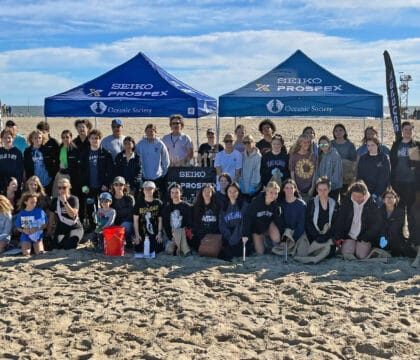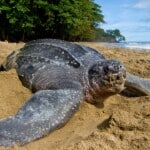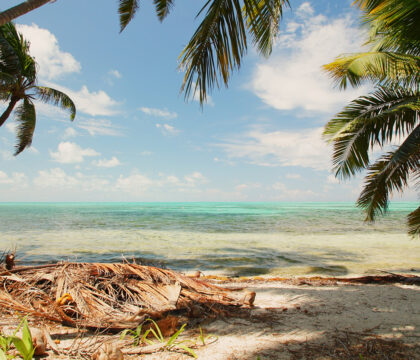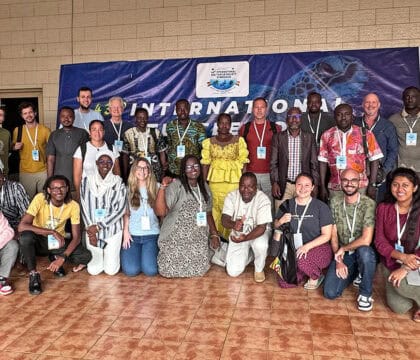April 24, 2014 • News Announcements, Program Updates
Hello, friends and supporters of the Whales of Guerrero Research Project! Whew! What an incredible pilot year that was. You guys – it worked!
Getting to know our whales
Over the course of our ten-week study (we spent 300 hours on the water in all), we had 47 encounters with groups of whales ranging from one to five individuals. We estimate that we saw about 77 different whales and now have 25 beautiful fluke IDs to share with the world to see if we have any matches.
[IMAGE]
A few more interesting discoveries and accomplishments:
- About 1/3 of the whales we saw were cow/calf pairs.
- Our whales appear to be champion breath holders; they stay down for an average of 12 minutes between breath cycles, which is 4-6 minutes longer than most humpback whales do in similar situations elsewhere.
- We heard whales singing much of the time when we dropped our hydrophone and were able to record the full song cycle more than once.
It doesn’t stop with the whales
We identified three types of dolphins, including the little known rough toothed dolphin.
We made underwater video of a pair of rough toothed dolphins investigating a dorado (mahi mahi) and photographed others breaching, playing and feeding. Some biologist is going to be really excited to find out that we have rough toothed dolphins around here. We also recorded vocalizations of pan-tropical spotted dolphins and rough toothed dolphins.
We identified at least 4 different types of rays, saw sea turtles almost every day, spotted a mystery whale (perhaps a minke or Bryde’s whale), noted the ebb and flow of fantastically varied bird life around the Morros and beyond, which is to say, we began to map out a truly amazing marine tour for future ecotourists.
A new mystery
When I began this project, I assumed our migratory humpback whales were members of the Banderas Bay group with a bit of wanderlust. But most of the whales we saw early on in the season were traveling south in a hurry. So now, the new question I have is ARE these whales in fact a part of the Banderas Bay population? Are they part of a little known or unknown group in Oaxaca or Costa Rica? Nicaragua? Somewhere else? The 25 tail IDs and songs we have will provide the first clues to unlocking this mystery.
Locals are into it
We’ve now got a village full of kids who zip around on their bikes singing whale songs. Also just about any kid can demonstrate a solid breach, fin slap, tail lob or spy hop for you. The whale workshops we gave in the library and kindergarten along with lots of hammock and taco time with families in the evenings got villagers hooked on finding out how many whales we spotted each day. Fishermen started calling us when they saw whales.
My boat operator, Arturo Mellin, became an expert in safe boat operation around humpback whales and is also now well-versed in basic humpback whale biology and behavior. I am confident that he will always maneuver a boat with the utmost responsibility around whales and dolphins and will share his expertise with the other guides.
A number of other village tour guides are studying English for the first time to make interaction with visitors easier, which tells me they believe in the potential of ecotourism. Various village families hosted members of our team which fostered deep cultural interchange and village women became project stakeholders. People who helped us a lot with whale spotting or did their part to make our events run smoothly and the kids who came to workshops and were truly stellar participants were given the opportunity to name and adopt one of the whales we photo identified. These new whale patrons are likely to be the first people to be straining their eyes at the horizon, hoping to spot ‘their’ whales when they return next year. Overall, the project brought a new sense of appreciation for the richness of nature in this area to the local community and it inspired them to see value in protecting and promoting it. The seeds have been planted. The soil is good. This project wants to grow.
Next Steps
Boutique ecotourism: We are beginning to lay the groundwork for small groups of people to come down and participate in our project for a day or a week as citizen scientists and do a deep dive into the cultural riches of this sweet little village and extraordinary natural surroundings.
Putting a robust whale spotting network in place: I am coordinating with regional radio-wielding sport fishermen to set up a solid whale spotting network and also pulling together a volunteer-run land-based whale spotting field station out of the lighthouse above Playa Las Gatas. We’ll also launch an ‘if you see something say something’ whale awareness campaign for whale-obsessed beach dwellers next fall. This will be citizen science at its best.
Building next year’s team: Pablo Mendizabal, who is committed to the project’s success in Zihuatanejo and Ixtapa, and I are going to SOMEMMA, the Mexican Marine Mammal Society symposium in Queretaro from May 9 – 15.
The geek in me is super excited to learn how to build a hydrophone out of inexpensive materials readily available in Mexico so that I can teach locals how to do the same.
The main purpose of our trip is to meet with the heads of marine biology programs from respected universities in Mexico, share our data with other scientists who are studying humpback whales in the North Pacific and scout out Latin America’s best and brightest marine mammal students and scientists for potential internships with our program next year. We’ll need a bigger team, as I hope to expand our study area to include: Playa Blanca, Playa Tortuga, Zihuatanejo, Ixtapa, Troncones and La Majahua. I will be looking for students who are bilingual, skilled on-water spotters, data collectors, photographers, socially savvy, enthusiastic and good teachers. I am optimistic that we will find the beginnings of next year’s team in Queretaro, since these are the kind of people you find at marine mammal science conferences.
I’m also at work spreading the word about our project. I will be giving talks about our findings in a number of locations around the US and Mexico over the next 6 months. I am also introducing our project to esteemed marine biologists and conservationists who will bring their experience and insight to our now-forming scientific advisory board to collaborate with us and steer us in the right direction scientifically, environmentally and culturally.
I have never worked so hard nor felt so in alignment with my life’s mission as I do now, working on the Whales of Guerrero Research Project. Even when presented with hurdles and snafus, it is quite clear to me that this project wants to exist and move forward, and everything is coming together just as it should. It was a crazy thing to launch this project just three months after coming up with the idea, but thanks to your support, it happened and so here we are on our way to year two!
Want to help us continue?
Here are 5 things you can do:
- E-mail me with a pledge to be a sustaining donor of the project over the next 4 years or make a tax-deductible donation to our project right now.
- Ask if your company will match your donation.
- If you haven’t already, like us and follow us on Facebook.
- Ask your local school to adopt and name a whale for $1,000 USD. (Andy Wex, our singing biologist’s high school Aquanauts club sold $1,000 worth of Krispy Kreme donuts to adopt and name Whale #23, now known as Ferdinand the Whale.) Contact us for details.
- Share our project with a friend.
Thank you for letting us work to find out how many whales we have down there, where they hang out, where they COME from, and thank you for allowing me and my team to teach people so much great stuff about whales. The whales, the ocean and the people who are their local custodians are all in a better position to thrive thanks to your support.
Viva las Ballenas!




